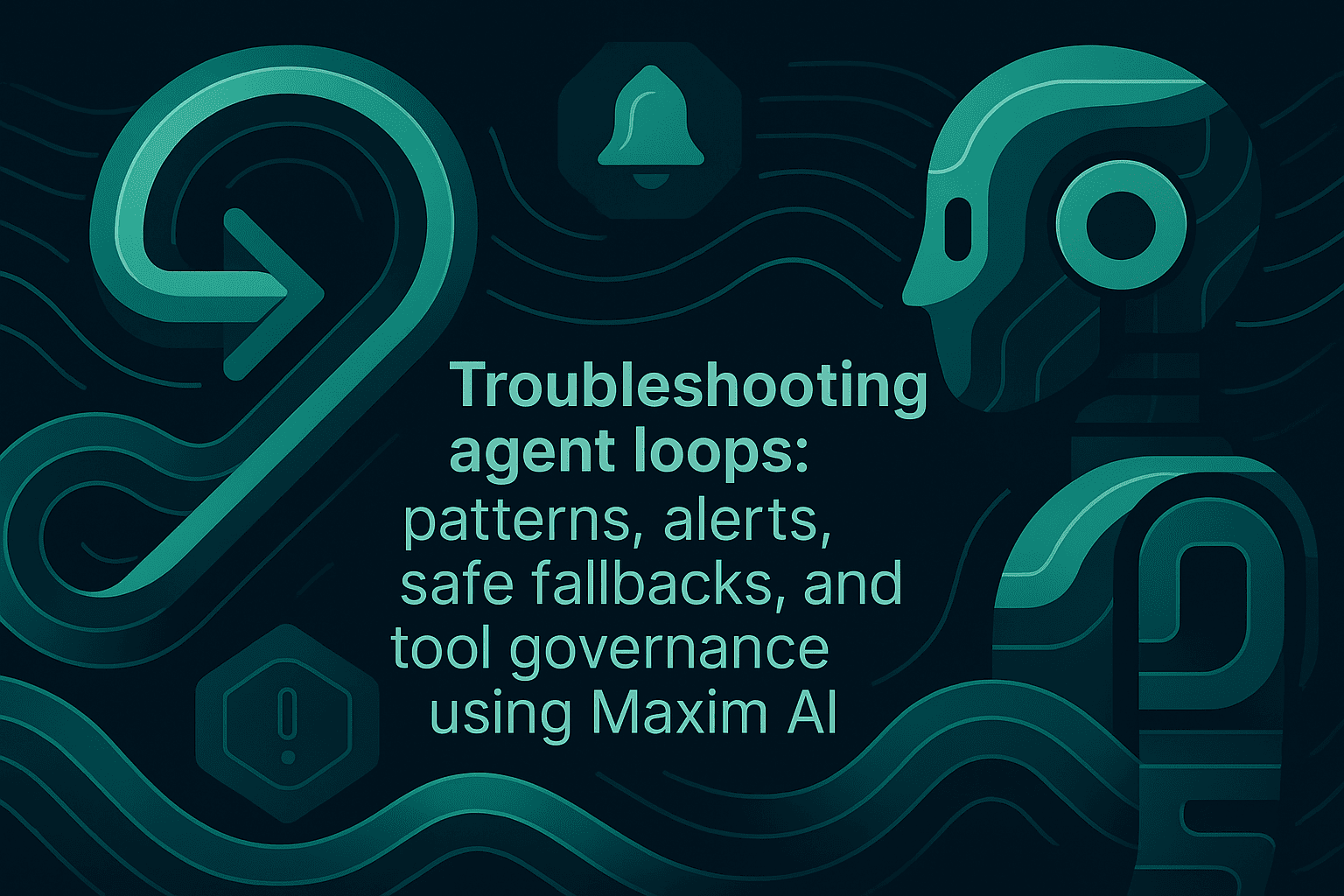Troubleshooting agent loops: patterns, alerts, safe fallbacks, and tool governance using Maxim AI

TL;DR
Agent loops occur when an AI agent repeatedly cycles without making progress. Prevent them by combining robust tracing, loop-aware patterns, targeted alerts, deterministic safe fallbacks, and strict tool governance. Use Maxim AI’s end-to-end stacks: simulation, evaluations, observability, and Bifrost gateway, to detect, reproduce, and remediate loops across pre-release and production.
Troubleshooting Agent Loops: Why They Happen and What To Watch
Agent loops are repeated cycles where an agent keeps calling tools, re-prompting, or revisiting the same state without completing a task. Common root causes include ambiguous goals, over-permissive tool access, inconsistent prompt contracts, unreliable RAG retrieval, or model drift. In production, loops drive latency spikes, cost overruns, and poor user experience, making proactive detection and remediation critical for trustworthy AI.
Maxim AI provides a full-stack platform for simulation, evaluation, and observability to surface and resolve loop behavior before and after release. See Maxim’s end-to-end approach across experimentation, simulation, evaluation, and observability. Experimentation, Agent Simulation & Evaluation, and Agent Observability.
Establish Loop-Aware Patterns in Design
Adopt patterns that constrain agent trajectories and define termination conditions.
- Goal decomposition: Break tasks into atomic steps with clear success criteria to minimize ambiguous trajectories. Use Maxim’s Playground++ to version prompts and compare outcome quality, latency, and cost across models and parameters. Advanced prompt engineering.
- State machines and guards: Enforce bounded transitions with max-depth, max-tool-calls, and explicit “done” states. Re-run simulations from any step to reproduce issues and validate guards. Agent simulation.
- RAG precision-first: Prefer high-precision retrieval over broad recall; cap retries and apply confidence thresholds to avoid retrieval-repeat loops. Use evaluation runs on large test suites to quantify regressions. Evaluation framework.
- Deterministic stop rules: Define hard ceilings for iterations, tool invocations, and self-reflections; route to fallback flows once thresholds are hit. Measure conversational success and failure points across personas. Simulation highlights.
Trace, Detect, and Alert on Loop Signals
Make loops observable with distributed tracing and quality alerts.
- Span-level metrics: Track repetitive tool spans, identical prompts, high-similarity outputs, and retry clusters. Use Maxim’s observability to log production data and analyze with distributed tracing. Agent Observability.
- Loop heuristics: Configure detectors for:
- Excessive tool-call sequences in a short window.
- High cosine similarity across consecutive model outputs.
- Repeated retrieval queries with minimal content variation.
- No progress on task state despite multiple steps.
- Real-time alerts: Create rules for in-production quality checks and notify engineering when loop signatures cross thresholds; automatically flag sessions to curated datasets for postmortems and fine-tuning. Observability quality checks.
- Cross-version comparisons: Visualize evaluation runs across prompt versions to confirm whether fixes reduce loop frequency without harming task completion. Evaluation visualization.
Safe Fallbacks: Contain Impact and Recover Gracefully
When a loop is detected, route to safe, deterministic paths that preserve user trust.
- Escalation paths: Transition to human-in-the-loop review or a simplified deterministic workflow. Use Maxim’s human evaluations for last-mile quality checks on risky sessions. Human evaluations.
- Cached responses and answers: Serve validated, contextually relevant responses from semantic caches for known intents to reduce latency spikes. Bifrost’s semantic caching reduces cost and improves responsiveness across providers. Semantic Caching.
- Tool abstention: Halt tool access and return a concise clarification prompt with bounded options; log the incident for analysis. Observe these transitions in production logs with alerts to minimize user impact. Observability suite.
- Provider fallback: Use model and provider failover when loops are caused by model instability or degraded upstream. Bifrost supports seamless failover and intelligent load balancing across providers with zero downtime. Automatic Fallbacks and Load Balancing.
Tool Governance: Prevent Over-Permissioned Behavior
Govern tool access to reduce the chance of loops driven by unrestricted capabilities.
- Principle of least privilege: Limit tools to trusted contexts and specific intents; enforce quotas on calls per session. Configure usage tracking, rate limiting, and fine-grained access control. Governance.
- Structured tool contracts: Define strict schemas for tool inputs/outputs and reject non-conforming calls. Use Maxim’s custom plugins and observability to monitor misuse patterns end-to-end. Custom Plugins and Observability.
- MCP-driven capabilities: Use the Model Context Protocol to grant controlled access to filesystems, search, and databases with transparent auditing. Model Context Protocol (MCP).
- Budget management: Prevent runaway loops from incurring costs with hierarchical budgets, virtual keys, and team-level controls. Budget Management.
Pre-Release Simulation: Reproduce and Fix Loops Before Launch
Systematically test agents across scenarios to reveal loop-prone trajectories.
- Persona- and scenario-based runs: Simulate customer interactions across real-world contexts and measure success rates, turn counts, and tool patterns. Agent simulation capabilities.
- Fault injection: Introduce retrieval failures, tool timeouts, and malformed tool responses to validate fallback logic under stress. Re-run from any step to reproduce and isolate root causes. Re-run simulations.
- Evaluator store: Combine deterministic, statistical, and LLM-as-a-judge evaluators to score progress, helpfulness, and termination correctness; align agents to human preference with human-in-the-loop. Flexible evaluators.
- Data curation: Continuously build datasets from logs and loop cases; enrich with labeling and feedback to drive evaluations and fine-tuning. Data Engine.
Production Observability: Monitor Loops and Quality Regressions
Close the loop with live monitoring, alerts, and iterative improvements.
- Live tracing and repositories: Create separate repositories for different apps and environments; analyze sessions and spans with distributed tracing. Production data repositories.
- Automated evaluations: Run periodic quality checks on logs using custom rules to catch loop regressions early. In-production quality.
- Provider health: Track upstream provider latencies and error rates; rely on Bifrost’s unified interface and multi-provider support to route traffic safely. Unified Interface and Multi-Provider Support.
- Governance telemetry: Audit tool usage and enforce limits; integrate Prometheus metrics and tracing for comprehensive visibility. Observability (Prometheus, tracing).
Developer Experience: Rapidly Iterate on Prompts and Workflows
Optimize prompts and workflows to minimize loop-prone behavior.
- Prompt versioning and deployment: Organize, version, and deploy prompts from the UI; compare output quality, cost, and latency across models/parameters without code changes. Experimentation.
- Configuration flexibility: Use Web UI, API-driven, or file-based configuration to update routing and fallbacks quickly across environments. Configuration options.
- Drop-in replacement: Replace existing provider SDKs with Bifrost’s OpenAI-compatible API for unified routing, caching, and failover in one line. Drop-in Replacement.
- Team workflows: Enable product teams to configure evaluations and dashboards without code while engineering tunes SDK-level granularity. Custom dashboards and flexi evals.
Conclusion
Troubleshooting agent loops requires design-time constraints, loop-aware detection, targeted alerts, and disciplined tool governance. With Maxim AI’s end-to-end platform, Playground++ for prompt engineering, agent simulation and evaluations, production observability, and the Bifrost gateway—you can identify loop signals early, reproduce failures, apply safe fallbacks, and enforce governance policies at scale. This full-stack approach improves AI reliability, reduces costs, and accelerates delivery for agentic applications. Explore the product pages and docs to implement these controls across your stack. Request a demo or Sign up.


